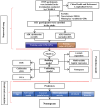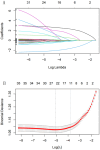Development and validation of a risk prediction model for activities of daily living dysfunction in stroke survivors
- PMID: 40520616
- PMCID: PMC12164166
- DOI: 10.3389/fneur.2025.1529724
Development and validation of a risk prediction model for activities of daily living dysfunction in stroke survivors
Abstract
Objective: Stroke is a leading cause of disability worldwide, imposing a significant burden on patients, families, and society. To create and verify a prediction model for activities of daily living (ADL) dysfunction in stroke survivors, pinpoint key predictors, and analyze the traits of those at risk.
Methods: Data from the China Health and Retirement Longitudinal Study wave 5 was used in this cross-sectional study. 1,131 stroke survivors were included and split into training and testing sets. The least absolute shrinkage and selection operator regression and multivariate logistic regression were applied for model development. Model performance was evaluated using the area under the receiver operating characteristic curve(AUC), calibration plots, and decision curve analysis. SHapley Additive exPlanations values were calculated to understand predictor importance.
Results: Six variables (age, the 10-item Center for Epidemiologic Studies Depression Scale score, memory disorder, self-rated health, pain count, and heavy physical activity) were identified as significant predictors. The model showed good discriminatory power (training set AUC = 0.804, testing set AUC = 0.779), accurate calibration, and clinical utility.
Conclusion: A prediction model for ADL dysfunction in stroke survivors was successfully developed and validated. It can help in formulating personalized medical plans, potentially enhancing stroke survivors' ADL ability and quality of life.
Keywords: ADL dysfunction; LASSO regression; nomogram; prediction model; stroke survivors.
Copyright © 2025 Lin and Liu.
Conflict of interest statement
The authors declare that the research was conducted in the absence of any commercial or financial relationships that could be construed as a potential conflict of interest.
Figures





Similar articles
-
A predictive model for social participation of middle-aged and older adult stroke survivors: the China Health and Retirement Longitudinal Study.Front Public Health. 2024 Jan 12;11:1271294. doi: 10.3389/fpubh.2023.1271294. eCollection 2023. Front Public Health. 2024. PMID: 38283296 Free PMC article.
-
Depression symptoms in perimenopausal women with somatic pain: nomogram construction based on a logistic regression model.Front Public Health. 2025 May 9;13:1528718. doi: 10.3389/fpubh.2025.1528718. eCollection 2025. Front Public Health. 2025. PMID: 40416662 Free PMC article.
-
Development, validation, and visualization of a novel nomogram to predict stroke risk in patients.Front Aging Neurosci. 2023 Aug 7;15:1200810. doi: 10.3389/fnagi.2023.1200810. eCollection 2023. Front Aging Neurosci. 2023. PMID: 37609032 Free PMC article.
-
Nomogram for predicting the 12-year risk of ADL disability among older adults.Aging Clin Exp Res. 2022 Jul;34(7):1583-1591. doi: 10.1007/s40520-022-02105-z. Epub 2022 Mar 17. Aging Clin Exp Res. 2022. PMID: 35301701
-
Development and Validation of a Nomogram for Predicting Nutritional Risk Based on Frailty Scores in Older Stroke Patients.Aging Clin Exp Res. 2024 May 18;36(1):112. doi: 10.1007/s40520-023-02689-0. Aging Clin Exp Res. 2024. PMID: 38761298 Free PMC article.
References
-
- Gil-Salcedo A, Dugravot A, Fayosse A, Jacob L, Bloomberg M, Sabia S, et al. long-term evolution of functional limitations in stroke survivors compared with stroke-free controls: findings from 15 years of follow-up across 3 international surveys of aging. Stroke. (2022) 53:228–37. 10.1161/STROKEAHA.121.034534 - DOI - PubMed
-
- Tsiakiri A, Plakias S, Vlotinou P, Terzoudi A, Serdari A, Tsiptsios D, et al. Predictive Markers of Post-Stroke Cognitive Recovery and Depression in Ischemic Stroke Patients: A 6-Month Longitudinal Study. European journal of investigation in health, psychology and education. (2024) 14:3056–72. 10.3390/ejihpe14120200 - DOI - PMC - PubMed
LinkOut - more resources
Full Text Sources

